Situated in Isfahan’s Naqsh-e Jahan Square, the Ali Qapu Palace (also written as Aali Qapu) is a stunning representation of Safavid architecture. Renowned for its exquisite design and decorations crafted by famed Iranian artists, it draws numerous visitors both locally and internationally. The palace boasts a grand entrance, opulent halls, a music hall on the highest floor, and beautiful artworks, with its main pillars crafted in wood, enhancing its architectural appeal.
Exploring Ali Qapu Palace
Ali Qapu Palace, prominently located on Naqsh-e Jahan Square’s western side, stands opposite the Sheikh Lotfollah Mosque. Once known as “Dowlatkhaneh-e Mubarak-e Naghsh-e Jahan” and “Qasr-e Dowlatkhaneh,” this palace spans 1800 square meters, rising to 38 meters across six floors. Unique for protruding from the surrounding square, it symbolizes the power of its era’s government. It was one of the most significant and splendid buildings of its time, beautifully built on a wooden base.
During the Safavid era, Ali Qapu Palace’s main entrance served as the access point to the royal buildings in Naqsh-e Jahan Square. Commissioned by Shah Abbas the Great to showcase his government’s power and glory, the palace hosted key government meetings, foreign dignitary receptions, and state ceremonies. The balcony also served as a viewing point for Shah Abbas to enjoy polo matches and horse riding events in the square.
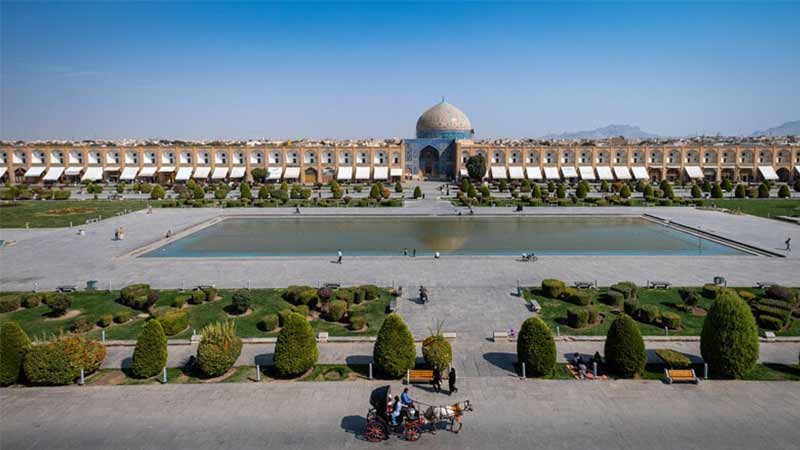
Highly revered during Shah Abbas I’s reign, Ali Qapu Palace was not accessible to just anyone. Today, this six-story structure continues to fascinate many visitors.
Known as the tallest palace from the Safavid period, Ali Qapu features steep stairs leading to its upper floors. While climbing these stairs might be a challenge, they lead to a splendid veranda with wooden columns, 20 meters high, offering a fantastic view of Naqsh-e Jahan Square. From this vantage point, visitors can see the Sheikh Lotfollah Mosque, the Qeysarie Gate, and the Shah Mosque. This palace is one of the must-see places in Iran cultural tours.
The Origin of the Name Ali Qapu
Ali Qapu is pronounced in two ways, each reflecting its unique origin. ‘Ali Qapu,’ commonly used in conversation, combines the Persian ‘ali’ (meaning high or great) and the Turkish ‘qapu’ (gate), translating to ‘High Gate!’ In its early days, the entrance to Ali Qapu was revered, with entrants required to show respect. Even Shah Abbas would dismount his horse before entering. The palace also served as a sanctuary for offenders, who were protected once inside, unless the Safavid Shah ordered otherwise.
Another theory suggests that Shah Abbas the Great brought the original door of Imam Ali’s shrine from Najaf to Isfahan, installing it at Ali Qapu’s entrance. Hence, it was named ‘Ali’s Gate,’ linking it with the shrine and earning high regard from both the Shah and the people.
Ali Qapu Palace’s Rich History
Ali Qapu Palace’s origins date back to the Safavid era when Isfahan was the capital. Historical records suggest it was built over a palace from the Timurid era. Its construction began around 1054 AH under Shah Abbas I and continued through the reigns of Shah Abbas II and Shah Sultan Hussein, taking nearly a century to complete. The building’s foundation is primarily credited to Shah Abbas I and II, while its restoration and decoration occurred under Shah Sultan Hussein.
The interior of the palace is adorned with significant calligraphy and miniature art, marking the completion of Ali Qapu Palace after Shah Abbas I’s death. As part of the capital’s move from Qazvin to Isfahan, the palace was designed by Iran’s top architects.
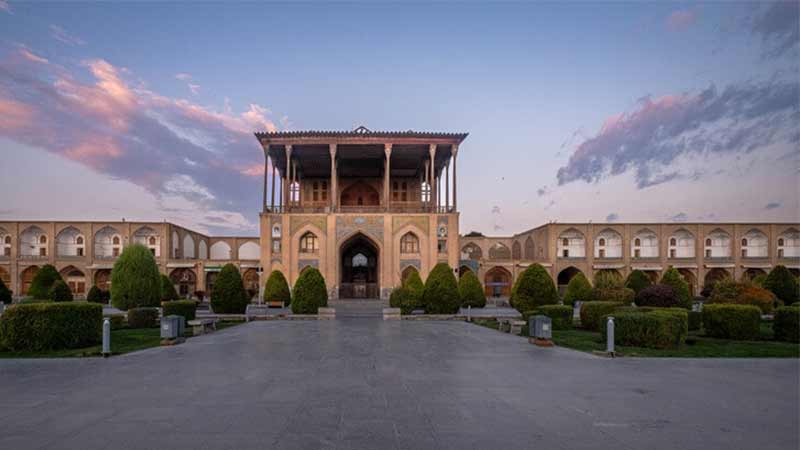
Ali Qapu’s Architecture and Renovations
Over time, the Ali Qapu Palace underwent various changes during the reigns of Shah Abbas I, II, and Shah Sultan Hussein. The palace originally served as a link between the Naghsh-e Jahan Garden and surrounding buildings, utilized by the king and courtiers for official functions. With Isfahan’s growth, the palace expanded, adding more floors and a veranda with 18 wooden columns during Shah Abbas II’s reign. This era is considered the golden age of the Safavids.
Later, a music hall was added to the top floor, distinct from other parts of the palace in its architectural style and decoration. Over the years, the palace has faced damage due to wars, neglect, and natural factors, leading to various restoration efforts, including a 12-year project completed recently, with ongoing renovations in other parts. This palace has been one of the architectural wonders of Iran.
Visiting Ali Qapu Palace
Ali Qapu Palace is easily accessible in Isfahan, located on Naqsh-e Jahan Square’s western side. The square, near the city’s north, can be reached via Hafez and Sepah Streets, with parking available on Sepah Street. The area is typically busy, so planning your visit earlier in the day is advisable to avoid crowds.
Location of Ali Qapu Palace
Ali Qapu Palace is prominently located in Isfahan, on the western side of the bustling Naqsh-e Jahan Square. Situated in the heart of the city, close to northern Isfahan, the palace is easily accessible from Naqsh-e Jahan Square. To reach it, visitors can use Hafez Street from the east and Sepah Street from the west. For those visiting Ali Qapu Palace and Naqsh-e Jahan Square, Sepah or Saadi Streets are convenient entry points from Governorate Street, located on the square’s western side. Sepah Street is particularly recommended for those driving, as it offers parking facilities. However, the area around the square can get very busy, especially on holidays, so it’s advisable to plan your visit earlier in the day.
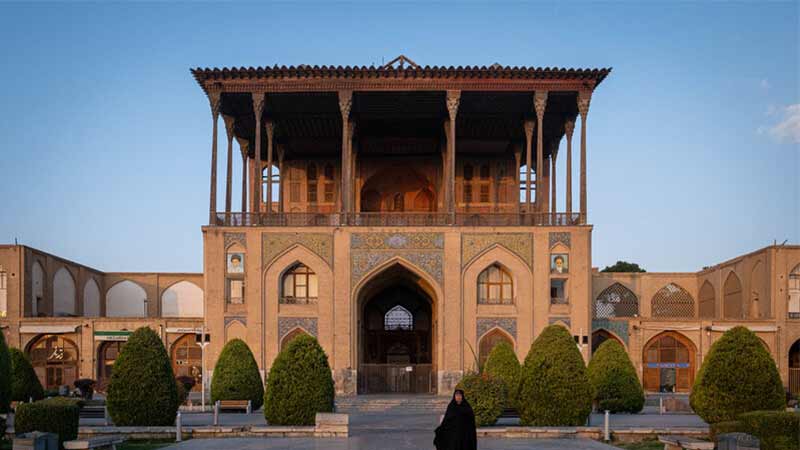
Ali Qapu Palace Address and Visiting Information
Address: Isfahan City, Governorate Street, Sepah Street, Naqsh-e Jahan Square, western side of the square
Visiting Hours: Daily from 9 AM to 6 PM
Ticket Prices: 3,000 Tomans for domestic tourists, 20,000 Tomans for foreign tourists
Closed Days: 14th and 15th of Khordad, 21st of Ramadan, 28th of Safar, Tasu’a, and Ashura.
Layout of Ali Qapu
Ali Qapu Palace, with its six floors, stands about 48 meters tall. The rooftop, offering a panoramic view of the city, is often considered an additional floor, giving the palace a total of seven floors. The building is connected by three staircases, with the first floor housing two main halls, previously used for administrative purposes and known as “Sadr Khaneh” or “Keshik Khaneh.”
The palace’s facade is distinguished by a large veranda with tall wooden columns. Due to its unique design, the number of floors visible varies depending on the viewing angle. From Naqsh-e Jahan Square, it appears two-storied, while from the sides, it looks three-storied, and from the back, it seems to have five floors. The palace is divided into two main sections: the entrance area and the main building.
The entrance was historically designed to be wide and accommodating. Just above it, there’s a porch area. Rooms on either side of the entrance were used for administrative activities. Inside, a north-south corridor leads to the palace’s main building.
Two spiral staircases provide access to the upper floors, culminating in a zigzag staircase used by the royal family.
The palace’s upper section comprises three floors, each divided into two parts. The large porch on the third floor, 28 meters high, features 18 wooden columns and once had a copper basin for water spouting. Large rooms are centrally located on each floor, with smaller rooms around them.
The palace’s most notable architectural feature is the music hall on the top floor. This hall, approximately 63 square meters and shaped like a Chalipa, has walls adorned with carvings of goblets and musical instruments. These carvings help to echo music throughout the palace. The hall comprises three rooms, two large and one small, and is considered one of the palace’s most beautiful areas. European artist Fred Richards has praised the plasterwork here, likening it to a meticulously assembled puzzle.
The copper basin, an engineering marvel made of stone and copper, was installed on the palace’s porch for water supply to the upper levels. Although currently not in use, it was designed to keep the air cool and was installed during Shah Sultan Hussein’s reign.
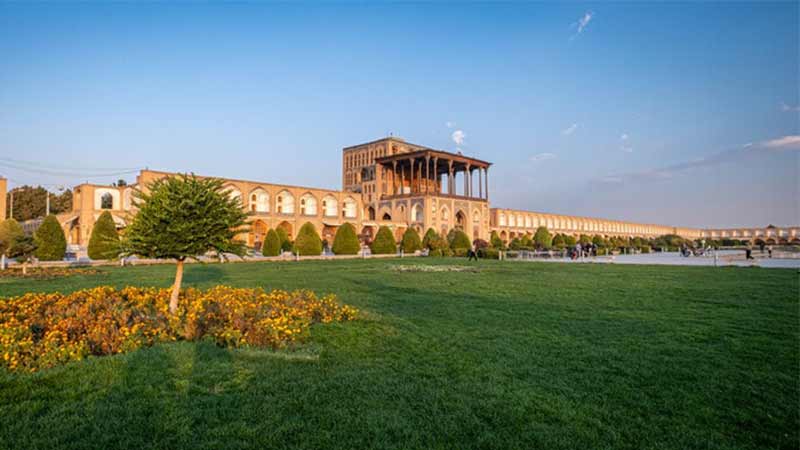
Ali Qapu Palace Entrance
Historically, the entrance of Ali Qapu Palace was crucial, acting as the main passage to the Naqsh-e Jahan Garden and several significant buildings, including the Government House and Stable Hall. Known as the “Government House Gate,” it connected various parts of the square and held a special place among the people. Shah Abbas I is said to have brought the original gate of Imam Ali’s shrine from Najaf to this entrance after making a silver offering there.
Today, while the main entrance in Naqsh-e Jahan Square is widely recognized for its beauty and prominence, Ali Qapu Palace actually has five entrances. These include the Four Ponds Door on the north side, the Royal Door facing the city gate, the Harem Door, and the Jabeh Khaneh or Kitchen Door.
Architecture of Ali Qapu Building
Ali Qapu is a classic example of Safavid-era architecture. The palace and its main entrance were completed under Shah Abbas I, II, and Shah Sultan Hussein. The entrance gate plays a significant role in the building’s architecture, featuring an inscription that has partially faded over time. The inscription’s remnants suggest a political emphasis by Shah Abbas I on integrating Shia Islam with the government structure.
The building’s architectural design varies in appearance depending on the viewing angle. Stone platforms flank the entrance, leading to the main building, which features cross vaults and beautiful Esleimi and Khatayi patterns in a space measuring approximately 64 square meters. The acoustic properties of this area are impressive, allowing clear and loud sound transmission.
Access to the upper floors is via two spiral staircases, with the top floor specially designed like a large music studio. The sound engineering in this part of the building is particularly notable, as music played here could be heard throughout the palace. The design and craftsmanship of Ali Qapu Palace, considering its construction era, highlight the skill and creativity of its architects.

Interior Decorations of Ali Qapu Palace
Ali Qapu Palace showcases some of the most captivating interior decorations, a testament to its architectural significance. From the entrance to the music hall at the very top, the palace is adorned with exquisite Iranian and traditional motifs, all crafted by skilled Iranian artists. Each floor presents its unique decorations, featuring stunning plasterwork and paintings.
One of the most striking features in the past was the third floor’s wooden columns, all embellished with mirror work. The porch ceiling was beautifully decorated with wood carvings and artistic patterns. Unfortunately, much of the mirror work and several paintings have been lost over time.
From the small porch behind the hall on the third floor, visitors can see the dome of Tohid Khaneh. During the Safavid era, the porch was a favored spot for kings to watch events in the Naqsh-e Jahan Garden. The central copper basin, once adorned with marble and fountains, no longer retains these features.
The top-floor music hall is a highlight, with its three-dimensional plasterwork and carvings of goblets and musical instruments. This part of the mansion showcases exceptional sound engineering, a marvel considering its construction era. The paintings here, different from those in other parts of the palace, display a blend of traditional Iranian and Western art styles. This area of the palace is distinctly more modern in its artistic expression.
The interior also features works by Reza Abbasi, a famous Safavid-era artist, although some of these pieces have suffered damage. The exterior decorations of the palace are just as impressive, displaying traditional motifs, seven-color tiles, and intricate plasterwork. This plasterwork, particularly notable for its “Kashte Bari” style, is delicate and resembles paintings from a distance.
The palace is also known for its use of elaborately patterned carpets and extensive Muqarnas decorations, typical of historical Islamic architecture. These decorations vary in shape and add to the palace’s aesthetic appeal.
Interior Highlights in Ali Qapu Palace
Inside Ali Qapu Palace, the walls, arches, and ceilings feature a unique art form called gilding, which involves applying gold over a layer of Chinese material. This process fills the grooves with liquid gold, giving the artwork an exquisite shine.
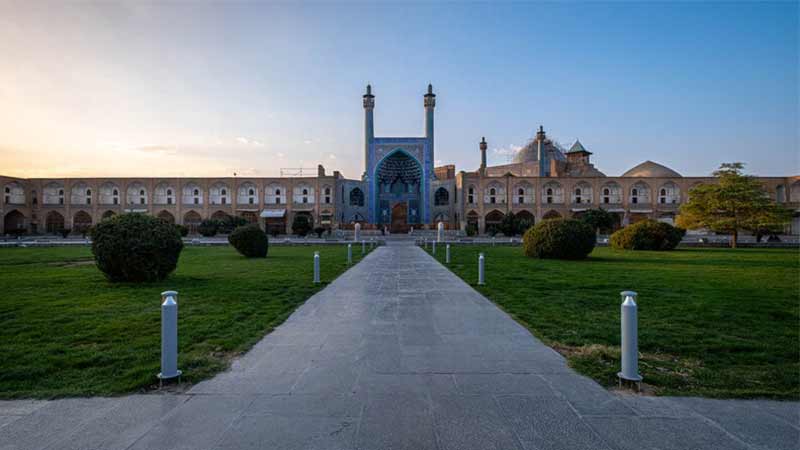
Inscriptions and Art in Ali Qapu Palace
Inscriptions within the palace indicate repairs made during Shah Sultan Hussein’s reign. While poems adorn the walls, damage has left only fragments readable. The top floor’s decorative paintings and gypsum carvings, resembling various jars and bottles, are particularly delicate and enhance the acoustic properties of the space.
Miniature Art in Ali Qapu Palace
The lower hall’s walls display stunning paintings, many by the renowned artist Reza Abbasi. These miniatures, featuring patterns of flowers, foliage, and various scenes, are among the palace’s most beautiful decorations, drawing the attention of art enthusiasts and tourists alike.
Ali Qapu Palace in Naqsh-e Jahan Square remains a significant historical and artistic landmark. If you’ve visited, we encourage you to share your experiences with us and other interested readers.
Conclusion
In conclusion, the Ali Qapu Palace in Isfahan serves as a majestic demonstration to Iran’s rich history and architectural brilliance. With its stunning interior decorations, intricate plasterwork, and the remarkable acoustic design of its music hall, the palace is not just a building but a journey through the artistic and cultural legacy of the Safavid era. Its strategic location in Naqsh-e Jahan Square adds to its magnificence, making it a must-visit for anyone looking to delve into the historical and artistic heritage of Iran. Whether you’re an admirer of intricate art, an enthusiast of historical architecture, or simply a curious traveler, Ali Qapu Palace offers an unforgettable glimpse into the cultural richness of Iran’s past. Are you intereseted in visiting this masterpiece? contact us on Parsi Tours website, Iranian travel agency.



